Winter 2022
I always feel relieved when another irrigation system blowout is completed. The system didn’t freeze from an abnormally cold November, and it signifies another season in the books for those up north. Our state has such a diverse climate, I am sure some of you are still irrigating and overseeding, while a few may be grooming cross country trails or ski runs. I think our 2022 events showcased this diversity as we visited Painted Dunes in El Paso, Picacho Hills in Las Cruces, Kokopelli Golf Club in Alto, Taos Country Club in Taos, and Sandia Golf Club in Albuquerque.
I would like to thank all the golf and F&B staff at Sandia Golf Club for a wonderful day. Many thanks to everyone involved with planning and executing the meeting at Sandia and our title sponsor for the event - Plant Nutrient Solutions for their continued support. A special thanks to Johnny Walker and Steve Randall for their unwavering support and leading a strategic planning session with the board last month. Moving forward I hope to build on a successful 2022 year. Implementing a budget for fiscal clarity and transparency, improving our event scheduling and planning, and understanding member needs, are a few goals that we aim to achieve that will bring continued stability and direction to the organization.
I am honored to be the Association President this past year and thank you for this great opportunity. I will continue in this position in 2023. I feel we have a strong group of talented board members that will work hard to implement what we have learned this past year. I feel they are up to the challenge to provide you as members the value and products that are expected from The Rio Grande Golf Course Superintendents Association.



EXCEL LEADERSHIP
I recently had the opportunity to speak at the 2022 EXCEL Nufarm Leadership Conference in Frisco, Tex. GCSAA's Katie Lomshek and Matt Brown help produce the leadership event, which is now in its fifth year. Every year, there are eight open spots for assistant golf course superintendents to apply. The application process consists of the standard questionnaire along with two written essays. Once selected to the program, the assistants begin a 3-year process where they attend a couple of leadership events during the year as well as the GCSAA Conference and Trade Show. Now that the program is in its fifth year, there are 1st-year members, 2nd-year members and 3rdyear members for a total of 24 people in the program.



The program is aimed at teaching these assistant superintendents how to elevate their professionalism through education and the real-world experiences of those in the turfgrass profession. It is not all classroom education: At this year’s event, the EXCEL class was treated to a tour of the new PGA Frisco golf courses and maintenance facility as well as a tour of the new PGA of America headquarters. The tour included a discussion with some of the directors of the PGA. All of these interactions will help the members of this program become better prepared and more marketable when they move into their first golf course superintendent position. When it came time for me to speak, I gave them insight to my career in the industry with a presentation titled “40 years in 40 minutes.” I stressed the points of being flexible in their short-term and long-term planning and of always having a Plan B.
This program would not be possible without a great company like Nufarm that sponsors this event. They also have employees of their company that attend the events with the assistants so there is always communication and feedback. I encourage all superintendents to make sure their assistants are aware of this program and assistants should talk to their superintendents about the program if they are interested. I enjoyed my brief time with this group and I look forward to watching the members of this group excel in this profession.
Field Staff Report - SOUTH CENTRAL REGION Johnny Walker | November 14, 2022

Our 2022 Annual Meeting was held at beautiful Sandia Golf Club in Albuquerque.
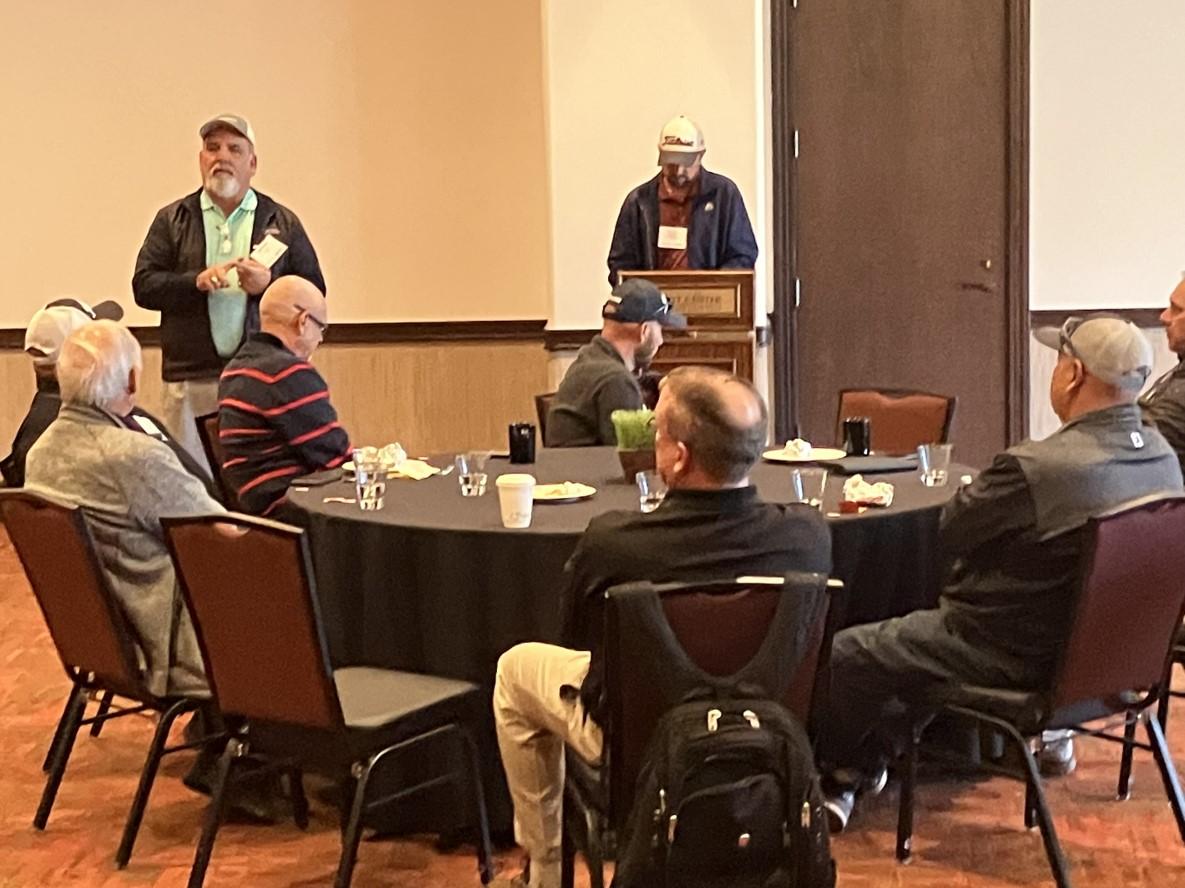

Thank you to all who participated in this important event. Congratulations and Thank You to the newly elected 2023 Board of Directors!

A huge thank you goes out to the entire Sandia Golf Club staff for making it a very special day.

Thank you to our Title Sponsor, Plant Nutrient Solutions for your support!


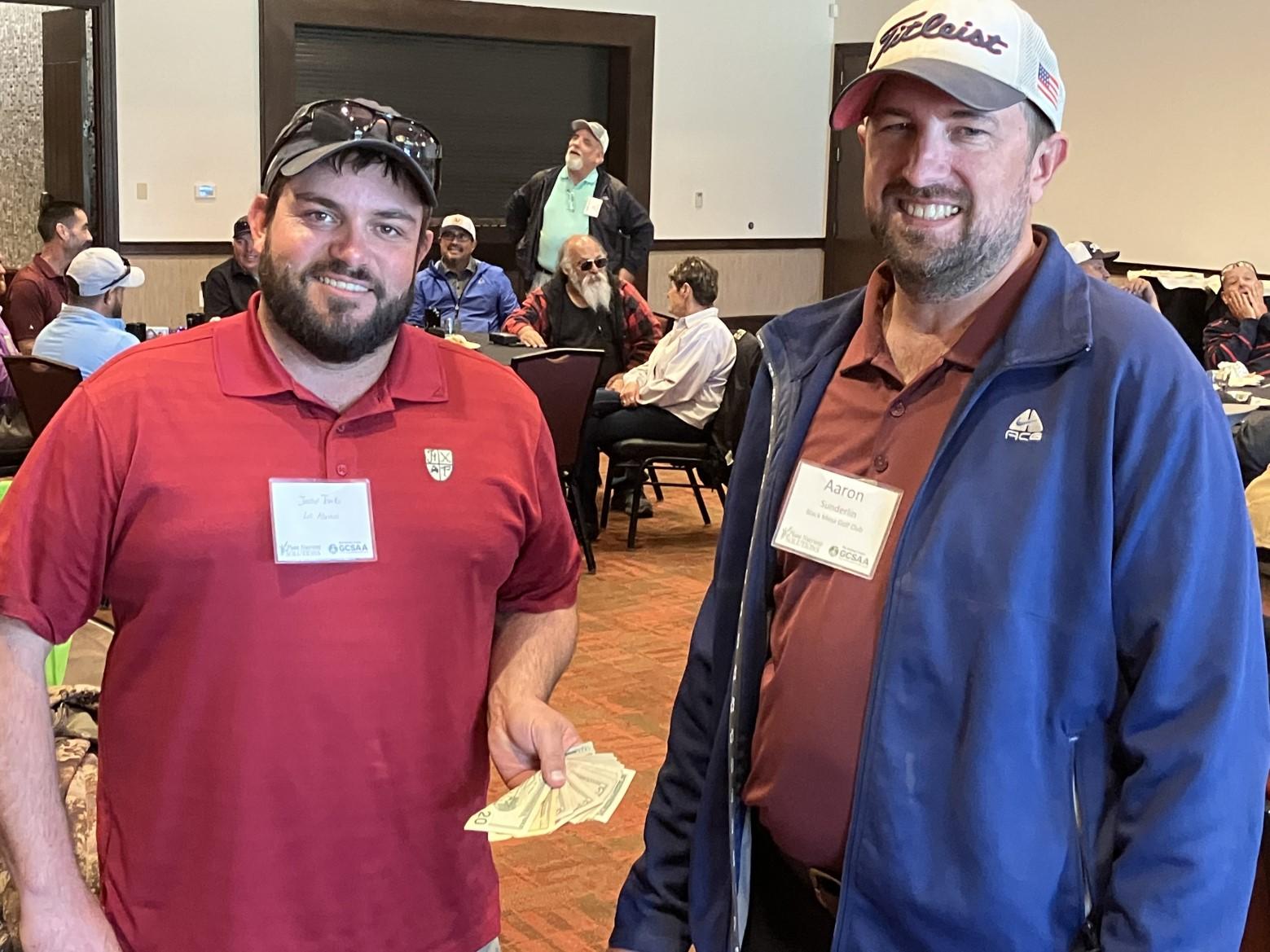







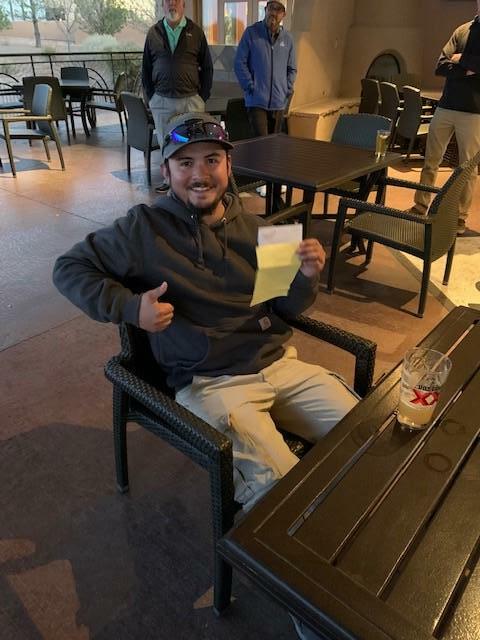

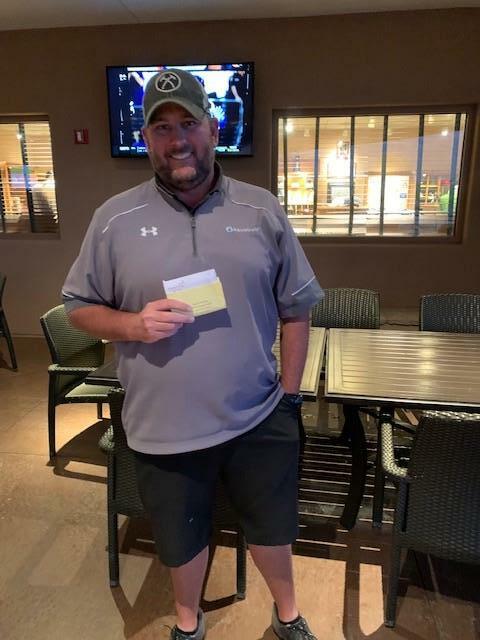




Click Ad


Click Here to RENEW your membership or JOIN as a new member. We value your participation!




Section 1 Planning, Design and Construction Section 2 Irrigation Section 3 Surface Water Management Section 4 Water Quality Monitoring and Management Section 5 Nutrient Management Section 6 Cultural Practices Section 7 Integrated Pest Management Section 8 Pesticide Management Section 9 Pollinator Protection Section 10 Maintenance Operations Section 11 Landscape Section 12 Energy
Dry air, low precipitation, little soil moisture, and fluctuating temperatures are characteristics of fall and winter in many areas of Colorado. Often there is little or no snow cover to provide soil moisture from October through March. Trees, shrubs, perennials and lawns under these conditions may be damaged if they do not receive supplemental water.
The result of long, dry periods during fall and winter is injury or death to parts of plant root systems. Affected plants may appear perfectly normal and resume growth in the spring using stored food energy. Plants may be weakened and all or parts may die in late spring or summer when temperatures rise. Weakened plants also may be subject to insect and disease problems.


Plants Sensitive to Drought Injury
Woody plants with shallow root systems require supplemental watering during extended dry fall and winter periods. These include European white and paper birches; Norway, silver, red, Rocky Mountain and hybrid maples; lindens, alders, hornbeams, dogwoods, willows, and mountain ashes. Evergreen plants that benefit include spruce, fir, arborvitae, yew, Oregon grape-holly, boxwood, and Manhattan euonymus. Woody plants also benefit from mulch to conserve soil moisture.
Herbaceous perennials and ground covers in exposed sites are more subject to winter freezing and thawing. This opens cracks in soil that expose roots to cold and drying. Winter watering combined with mulching can prevent this damage (See fact sheet 7.214, Mulches for Home Grounds.)
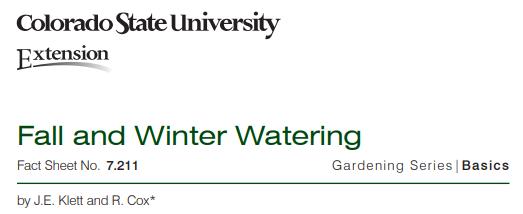
Lawns also are prone to winter damage. Newly established lawns, whether seeded or sodded, are especially susceptible. Susceptibility increases for lawns with south or west exposures.
 *J.E. Klett, Colorado State University Extension horticulture specialist and professor, horticulture and landscape architecture; and R. Cox, Extension horticulture agent, Arapahoe County. 3/13
*J.E. Klett, Colorado State University Extension horticulture specialist and professor, horticulture and landscape architecture; and R. Cox, Extension horticulture agent, Arapahoe County. 3/13
Watering Guidelines
Water only when air temperatures are above 40 degrees F. Apply water at mid-day so it will have time to soak in before possible freezing at night. A solid layer (persisting for more than a month) of ice on lawns can cause suffocation or result in matting of the grass.
Plants receiving reflected heat from buildings, walls and fences are more subject to damage. The low angle of winter sun makes this more likely on south or west exposures. Windy sites result in faster drying of sod and plants and require additional water. Lawns in warm exposures are prone to late winter mite damage. Water is the best treatment to prevent turf injury (see fact sheet 5.505, Clover and Other Mites of Turfgrass.)
Monitor weather conditions and water during extended dry periods without snow cover – one to two times per month.

Newly Planted vs. Established Plants
Newly planted trees are most susceptible to winter drought injury. Trees generally take one year to establish for each inch of trunk diameter. For example, a two inch diameter (caliper) tree takes a minimum of two years to establish under normal conditions.
Trees obtain water best when it is allowed to soak into the soil slowly to a depth of 12 inches. Methods of watering trees include: sprinklers, deep-root fork or needle, soaker hose or soft spray wand. Apply water to many locations under the dripline and beyond if possible. If using a deep-root fork or needle, insert no deeper than 8 inches into the soil.
Continued on next page

As a general survival rule, apply 10 gallons of water for each diameter inch of the tree. For example, a two-inch diameter tree needs 20 gallons per watering. Use a ruler to measure your tree’s diameter at 6" above ground level.
Newly planted shrubs require more water than established shrubs that have been planted for at least one year. The following recommendations assume shrubs are mulched to retain moisture. In dry winters, all shrubs benefit from winter watering from October through March. Apply 5 gallons two times per month for a newly planted shrub. Small established shrubs (less than 3 feet tall) should receive 5 gallons monthly. Large established shrubs (more than 6 feet) require 18 gallons on a monthly basis. Decrease amounts to account for precipitation. Water within the dripline of the shrub and around the base.
Herbaceous perennial establishment periods vary. Bare root plants require longer to establish than container plants. Perennials transplanted late in the fall will not establish as quickly as those planted in spring. Winter watering is advisable with late planted perennials, bare root plants, and perennials located in windy or southwest exposures.
Additional Information For more information, see the following Planttalk ColoradoTM script. 1751, Fall and Winter Watering: During Drought


Continued from Previous Page
Click
Ad

United States Golf Association

WEST REGIONAL UPDATE
Can Sand Topdressing Make Fairways Softer?
Brian Whitlark - Senior Consulting Agronomist

Many courses apply sand to fairways to improve the physical characteristics of the rootzone and dilute thatch and organic matter. In this article, I will share research conducted in an athletic field setting that has implications for topdressing golf course fairways.
A study completed in 2008 and published in 2010 –“Sand Topdressing Applications Improve Shear Strength and Turfgrass Density on Trafficked Athletic Fields” – evaluated cumulative sand topdressing rates of 0, 0.5, 1, 1.5 or 2 inches in one season applied from July 11 through August 15 in 2007 and repeated the process in 2008. Topdressing was applied at a 0.25-inch depth during each event. The native soil was a compacted sandy loam with a high bulk density of 1.6 grams per cubic centimeter and a low infiltration rate of only 0.12 inches per hour. The sand applied for topdressing was a well-graded material – meaning it had a fairly equal proportion of different sand particle sizes – comprised of 90% sand, 7% silt and 3% clay. The coefficient of uniformity (CU) of the sand was 8.0, which confirms the wide particle size distribution, and the infiltration rate was 6.1 inches per hour. As a reference, the recommended CU range for putting green construction sand is 1.8 to 3.5. The sand used in this study was not the typical coarsely graded sand often used to topdress golf course fairways.
Research shows that sand topdressing can be beneficial for golf course fairways, but too much sand can actually be detrimental.
Research plots were subjected to simulated traffic. The measures of performance in this study focused on turfgrass cover, the number of turf shoots per square foot and surface strength called turf shear, measured with the Clegg turf shear tester which measures divot resistance.
Sand Topdressing Proved Highly Beneficial
After two years of study, sand topdressing at a rate of 0.5 inches per year – in 0.25-inch applications – for a cumulative total of 1 inch of added sand resulted in the best performance of all

treatments as measured by a combination of turfgrass cover, shoot density and shear strength. Turfgrass cover, shoot density and shear strength increased for all treatments in year two, including the non-topdressed plots, but the shoot density in the topdressed plots increased by 228%, far surpassing the increase in control plots. Shear strength (divot resistance) was highest in year two in the untreated plots. Of the sand topdressed plots, the 0.5 inch per year program yielded the highest value.
The researchers concluded that the higher shear strength in the non-topdressed plots was due to the measurement interacting with the highly compacted sandy loam soil. In this case, the higher shear strength was not indicative of a positive characteristic, but rather a representation of the compacted soil with lower turf shoot density – about half the density of the sand topdressed plots – and lower turfgrass cover. Also of note is that although the heavier sand applications showed equally good turfgrass cover and slightly higher shoot density than the 0.5 inch per year treatment, they resulted in lower turf shear strength. The study shows that some sand is good, but a lot of sand will destabilize the surface. On a golf course fairway, this means higher risk of damage from golf cart traffic and softer playing conditions.
The overarching message from this study is that sand topdressing may be a good practice for golf course fairways and approaches if rates are limited to about 0.5 inches per year with split applications, which amounts to approximately 80-90 tons per acre per year. Additionally, the sand in this study encouraged a firmer surface due to the widely graded particle size distribution. If you are using a coarse sand that is narrowly graded, the firmness will not be as great and more sand will further destabilize the surface.

USGA announced as presenting partner for GCSAA Conference and Trade Show

The organization joins the Golf Course Builders Association of America and the American Society of Golf Course Architects as presenting partners of GCSAA's 2023 event in Orlando.
The United States Golf Association has increased its support for the Golf Course Superintendents Association of America (GCSAA), in an ongoing effort to advance education, research and career development in golf through the GCSAA Conference and Trade Show.
The USGA joins the Golf Course Builders Association of America (GCBAA) and the American Society of Golf Course Architects (ASGCA) as Presenting Partners of the GCSAA Conference and Trade Show. Hosted annually, the GCSAA Conference and Trade show offers a week of interactive education, handson experiences, and celebration of the golf course management industry. The 2023 conference is scheduled to take place Feb. 6-9 in Orlando, Fla.
“GCSAA golf course superintendents play a vital role in the future of golf, and their expertise and commitment to the environment have helped advance the game in so many innovative ways,” said Matt Pringle, Ph.D., managing director of the USGA Green Section. “The USGA and the GCSAA have a shared vision to ensure golf courses continue to thrive and golfers have a course on which to play in every community. We look forward to bringing the vision to life, starting with the conference, and far beyond it."
The USGA’s increased engagement with the GCSAA Conference and Trade Show includes active participation in the first-of-its-kind Interactive Grass Stage at the 2023 gathering. The Stage, a four-way collaboration between the GCBAA, GCSAA, USGA and ASGCA, covers 20,000 square feet on the trade show floor and features the conference’s most important discussions.
Several USGA Green Section agronomists and experts will also conduct a series of educational sessions as part of the conference’s schedule of events.

In addition to serving as a Presenting Partner at the conference, the USGA has also expanded its working relationship with GCSAA through a multi-year collaboration focused on supporting the environmental and economic sustainability of golf courses while also improving playing conditions for golfers.
“Collaboration is vital to golf’s future, and this is a clear case in which we can achieve so much more than we can do alone,” said Mike Whan, CEO of the USGA. “This is just the start, as golf leads the way to advance key issues like resource conservation, while keeping our courses healthy and viable for generations.”
“The USGA’s expanded role with the GCSAA Conference and Trade Show enables both the USGA and GCSAA to use our industry’s largest annual gathering as a platform to jointly share critical insights and valuable new approaches to golf course management in a face-to-face setting,” GCSAA CEO Rhett Evans said. “Their elevated involvement in the event is indicative of the overall increased collaboration between our two associations.”
The GCSAA Conference and Trade Show will be preceded by the GCSAA Golf Championships, presented by Toro.
To learn more and register for the GCSAA Conference and Trade Show go to www.gcsaaconference.com.

Click Ad


A MESSAGE FROM RHETT EVANS UPDATING MEMBERS ON THE 2022 FALL BOARD MEETING

With the end of the year quickly approaching, it’s easy to start reflecting on the accomplishments of the association and the profession in 2022. So, it seemed rather fitting that we had the opportunity to spend the Fall Board Meeting in October at the new PGA of America complex in Frisco, Texas, which showcases many great things about golf. Hosting the Board meeting in Frisco gave us the chance to meet with PGA of America executives to discuss key initiatives in the industry. We also had the opportunity to meet with members of the North Texas GCSA to discuss issues affecting members in the chapter and how GCSAA programs and services that can positively impact those issues. In addition to those meetings, we had a full agenda at the Board meeting. Here is a review of topics covered at the meeting:
Financial Update: While the net revenue from the Conference and Trade Show in San Diego was less than budget due to the impact of the pandemic, GCSAA is on track to achieve its bottom line goal for 2022. The financial markets continue to be highly volatile, but the Board and staff continue to investigate and implement ways to continue to stay ahead of these financial challenges and reduce costs where needed..
Awards: The Board selected the winner of the 2023 Outstanding Contribution Award, 2023 President’s Award for Environmental Stewardship, 2023 Emerging Leader Award and 2022 Edwin Budding Award. Watch GCSAA’s communications outlets for the official announcement of the recipients in the coming weeks.
Standard Operating Procedures: The Board approved the recommended revisions to the various SOPs for programs and services across the association.
GCSAA Conference and Trade Show: GCSAA Chief Marketing Officer Ed Several shared updates on the schedule and happenings for Orlando in 2023. Some new events include GCSAA $Bucks where attendees collect points on the show app as they visit booths ending in a live auction where attendees can use their points to bid on lifestyle items on Thursday, seven Interactive Facility Tours and an Interactive Grass Stage. Registrations continue to track with some of our highest attendance levels in the past. To register, visit gcsaaconference.com
Strategic Marketing Plan: GCSAA Chief Marketing Officer Ed Several shared updates on the schedule and happenings for Orlando in 2023. Some new events include GCSAA $Bucks where attendees collect points on the show app as they visit booths ending in a live auction where attendees can use their points to bid on lifestyle items on Thursday, seven Interactive Facility Tours, an Interactive Grass Stage and a breakfast to honor CTEMs. Registrations continue to track with some of our highest attendance levels in the past. To register, visit gcsaaconference.com.
Key Metrics: The following key metrics were shared:
• GCSAA membership remains strong at over 19,000, and we continue to exceed our annual goal in several key membership categories including Class A, ISM and EM.

• The number of GCSAA Grassroots Ambassadors continues to grow and is currently at 482.

As we are just a few short months away from the 2023 GCSAA Conference and Trade Show, our team is focused on bringing you an unforgettable experience, and I hope to see you there. I wish you the best as we head into the holiday season and hope you are able to enjoy time with family and friends.

I am excited for the future and looking forward to 2023.
Onward! Rhett
Click Ad

Click Ad
Check out this terrific USGA presentation regarding Greens Winter Stress. Click here to view the video on YouTube

This presentation was recorded on Nov. 17th, 2014. The panel includes Keith Happ, Bob Vavrek, and John Daniels who are members of the newly formed Central Region of the USGA Green Section. Last year, polar vortexes, record-setting cold temperatures and impressive snow and ice totals seemed to be daily news headlines. This year experts are predicting another frigid winter. Join the agronomists from the USGA Green Section in a short presentation discussing three simple ways to winterize your greens to reduce the potential for turf loss caused by cold, ice or wind desiccation. For daily updates from the United States Golf Association, visit us at www.usga.org, on Twitter (www.Twitter.com/USGA; www.Twitter.com/usopengolf) and on Facebook (www.Facebook.com/USGA; www.Facebook.com/ USOPEN).
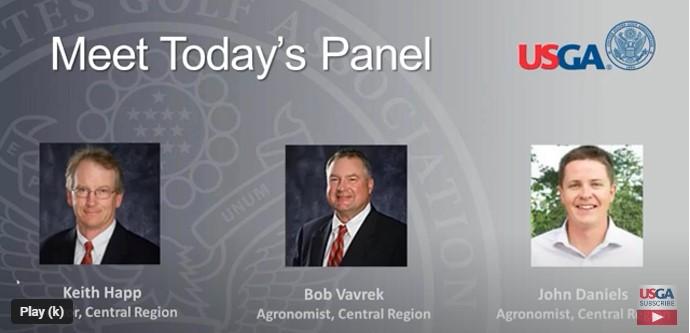

Click Ad
s Award for Environmental Stewardship

University of Florida turfgrass educator and researcher will receive award at the 2023 GCSAA Conference and Trade Show.

J. Bryan Unruh, Ph.D., professor at the University of Florida and associate director of the West Florida Research and Education Center, has been named the recipient of the Golf Course Superintendents Association of America’s 2023 President’s Award for Environmental Stewardship. He will be recognized during the Sunrise Celebration of the 2023 GCSAA Conference and Trade Show on Feb. 8 in Orlando.
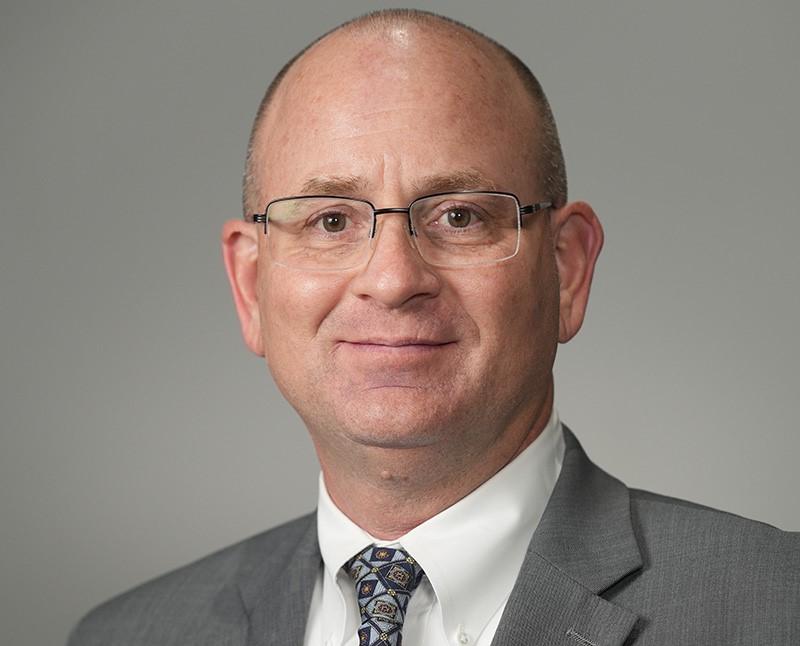
The President’s Award for Environmental Stewardship was established in 1991 to recognize an exceptional environmental contribution to the game of golf; a contribution that further exemplifies the golf course superintendent’s image as a steward of the land.
"Dr. Unruh has been instrumental in the development and expansion of golf course best management practices, which have truly been a game changer for the industry,” said Rhett Evans, GCSAA CEO. “His work has been invaluable to the game of golf and GCSAA members, and he personifies what the President’s Award for Environmental Stewardship is all about.”
Unruh’s road to nearly three decades at the University of Florida began in an unlikely place, Dodge City, Kan. While growing up in Dodge City, he was involved in 4-H, and attending a training on mowing lawns by his county Extension agent was his first introduction to turfgrass. After earning his bachelor’s and master’s degrees in horticulture from Kansas State University, he received his doctorate in horticulture from Iowa State University in 1995. Two weeks later, he joined the faculty at the University of Florida.
J. Bryan Unruh, Ph.D., honored with GCSAA’s President’
Click Ad
In 2003, Unruh played a key role in the launch of the effort to build environmental best management practices (BMPs) for Florida golf courses.

“You drive around Florida and you see a lot of sensitive ecosystems. This, coupled with a large golf industry, compelled Florida superintendents to be proactive and make sure their management practices minimize environmental impact,” Unruh said about Florida’s pioneering BMP work.
The Florida BMPs were published in 2007, and Unruh became a leading forced behind GCSAA’s initiative to have BMP manuals established for all 50 states, a goal that was achieved in 2020. Florida’s work was further validated earlier this year, when a state bill recognizing the Florida BMP Certification program was signed into law.
“It was unanimous in the state senate and had only one negative vote in the house. It really was a bipartisan effort,” Unruh said. “It memorializes the effort and recognizes the significant role that the golf industry has in Florida and the long record of environmental stewardship that Florida golf course superintendents have embraced.”
A 32-year GCSAA member, Unruh is also working with the association on the third phase of its Golf Course Environmental Profile Survey Series, a groundbreaking project to develop a comprehensive environmental profile of golf courses in the United States. He has also served on several national GCSAA committees, including the Research Proposal Review Committee and BMP Research Task Group.
Unruh has earned accolades from other industry organization as well, including Turfgrass Producers International’s Turfgrass Educator Award of Excellence and the Florida Turfgrass Association’s Wreath of Grass Award and Presidential Award. He is also a fellow of both the





























































